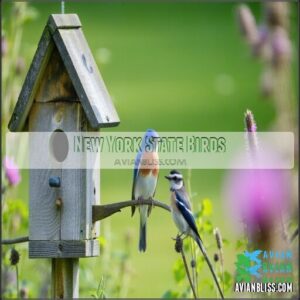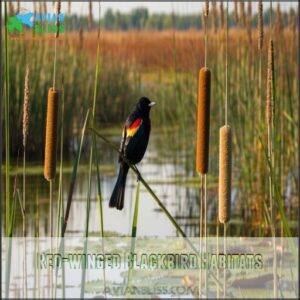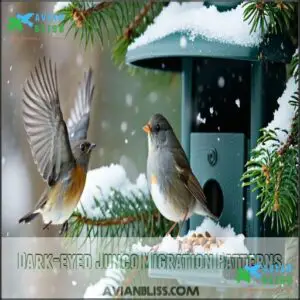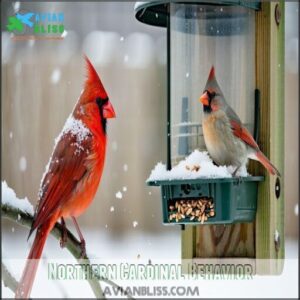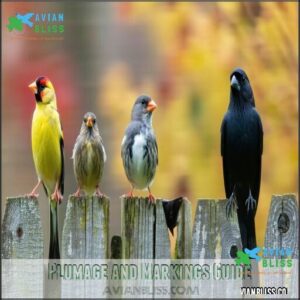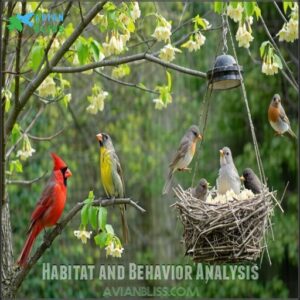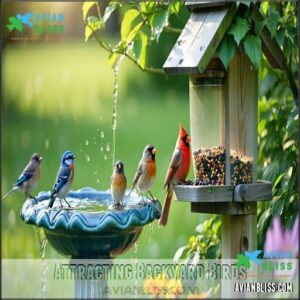This site is supported by our readers. We may earn a commission, at no cost to you, if you purchase through links.
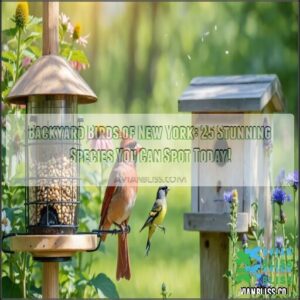
You’ll spot Northern Cardinals, with their bold red feathers and sweet whistles, often perched near feeders.
Bright American Goldfinches, known for their sunny yellow plumage, love thistle seed.
In spring, the Red-winged Blackbird’s signature call signals warmer days.
Eastern Bluebirds, New York’s state bird, bring charm as they nest in nearby boxes.
Even winter welcomes Dark-eyed Juncos, which hop along snowy ground.
By planting native plants and skipping pesticides, you’ll attract these stunning visitors all year.
Curious about their songs or behaviors?
Keep watching, and enjoy the beauty of these diverse bird species in your backyard, creating an ecological balance with native plants.
Table Of Contents
- Key Takeaways
- New York State Birds
- Common Backyard Birds
- Bird Identification Tips
- Attracting Backyard Birds
- Bird Conservation Efforts
- Frequently Asked Questions (FAQs)
- What is the invasive bird in New York?
- What is the largest bird in upstate New York?
- How do I identify a bird in my backyard?
- What is the most common bird in New York?
- What is the New York state bird?
- How do I know what birds are in my area?
- Are there birds in New York?
- Do bird feeders attract birds in New York?
- Is New York suitable for birding?
- Where do acrobatic birds live in New York?
- Conclusion
Key Takeaways
- Plant native vegetation and avoid pesticides to create a bird-friendly habitat that supports species like Eastern Bluebirds and Northern Cardinals.
- Use feeders with seeds, suet, or nectar to attract common backyard birds like American Goldfinches, chickadees, and Northern Cardinals.
- Observe bird behaviors to improve your identification skills and enjoy watching seasonal patterns of New York’s native species.
- Join bird conservation efforts like Project FeederWatch to help track populations and contribute to protecting New York’s 450+ bird species.
New York State Birds
You’ll find over 450 bird species throughout New York State, including the Eastern Bluebird which serves as the official state bird with its striking blue plumage and reddish-brown breast.
From your backyard feeder, you can observe incredible diversity ranging from the most frequently spotted American Goldfinch to the distinctive Black-capped Chickadee, all contributing to insect control and environmental balance.
Eastern Bluebird Characteristics
The Eastern Bluebird, New York’s official state bird since 1970, features striking blue plumage on its upper body and a warm reddish-brown breast.
New York’s Eastern Bluebird dazzles with vivid blue plumage and a reddish-brown breast, a gem of open woodlands since 1970.
You’ll immediately recognize this small thrush by:
- Its brilliant azure-blue back and wings that catch sunlight like sapphires
- The rusty-orange chest that contrasts beautifully with its white belly
- Males’ more vibrant coloration compared to females’ muted, grayish-blue tones
These backyard birds prefer open woodlands and meadows, where they hunt insects from perches and nest in tree cavities, making them a common sight in areas with open woodlands.
Bird Diversity Across New York
You’ll be amazed at how New York teems with avian life! The state hosts 454 bird species, with 242 breeding within its borders.
From the Adirondacks to Long Island, habitat variation creates diverse species distribution. Regional differences mean backyard birds in Buffalo differ from those in NYC.
The Atlantic Flyway migration patterns bring seasonal visitors, making New York bird diversity exceptionally rich.
Conservation priorities focus on protecting these varied habitats that support everything from tiny warblers to majestic herons. Visual identification relies on distinct beak shapes and plumage.
Role in Controlling Insect Populations
Backyard birds serve as nature’s own pest management team.
Nature’s tiny pest controllers, backyard birds help maintain balance, devouring thousands of insects daily while adding beauty to your surroundings.
Their insectivore diets help maintain ecosystem balance through natural predation of mosquitoes, caterpillars, and other garden pests.
A single Eastern Bluebird family can consume up to 2,000 insects daily, contributing substantially to the food web.
When you welcome birds into your yard, you’re not just enjoying their beauty—you’re enlisting allies in pest control that reduce the need for chemical treatments while supporting bird conservation efforts.
Common Backyard Birds
You’ll find 29 distinct bird species regularly visiting New York backyards, from the vibrant American Goldfinch with 173,405 recorded sightings to the distinctive Blue Jay with 79,649 observations.
These adaptable creatures inhabit urban settings, suburban gardens, and rural landscapes across the state, providing daily opportunities for observation and appreciation of their unique behaviors and characteristics.
American Goldfinch Sightings
The golden flash of an American Goldfinch signals New York’s most frequently spotted bird, with an impressive 173,405 recorded sightings.
You’ll find these bright visitors abundantly near thistle plants and feeders throughout the state.
Their population health remains strong as they top bird sighting lists in multiple counties, including Rensselaer, and their feeder preferences make them common backyard companions.
Gathering seasonally for feasts on elm saplings in places like Inwood Hill Park.
Red-winged Blackbird Habitats
The Red-winged Blackbird thrives in diverse bird habitats, especially marsh ecology and wetland conservation areas.
You’ll spot them near:
- Reed-filled ponds and marshes.
- Suburban gardens with dense vegetation.
- Open fields bordering wetlands.
- Migration stopovers with abundant food sources.
- Nesting sites in cattails or shrubs.
Their striking red-and-yellow wing patches make them unmistakable among New York’s garden birds.
Dark-eyed Junco Migration Patterns
Dark-eyed Juncos, often called "winter birds" in NY, showcase fascinating migration timing.
Females travel south before males, influenced by environmental changes and junco population genetics.
Breeding ground locations in mixed forests host these sparrows each spring.
Their winter range spans open woods and lawns, and watch for their distinctive white tail feathers as they hop between feeders, seeking seeds.
Northern Cardinal Behavior
While Dark-eyed Juncos often travel in flocks, Northern Cardinals prefer solo performances.
Males showcase bright red feathers, serenading with distinct vocalizations like "cheer-cheer-cheer."
Their behavior reveals fascinating traits:
- Mating rituals—males feed females during courtship.
- Territorial defense—they chase rivals relentlessly.
- Foraging habits—they prefer seeds, searching under feeders.
- Social interactions—pairs often stay together year-round.
They’re also attracted to yards with properly stored seeds.
Bird Identification Tips
You can identify backyard birds by focusing on their distinct plumage patterns, behaviors, and habitats.
Learning their calls and songs can also help you quickly recognize species common to New York.
Plumage and Markings Guide
Feather coloration and distinctive identifying markings are key to bird species identification.
Seasonal plumage can change a bird’s look, so don’t let that trick you.
Juvenile plumage often features muted tones, making it tricky to spot familiar colors.
Use birdwatching guides to note traits like wing bars or tail patterns.
Understanding regional variations helps identify common birds in NY.
To properly identify birds, consider a detailed plumage guide.
Here’s an at-a-glance guide:
| Bird Species | Markings | Seasonal Changes |
|---|---|---|
| American Goldfinch | Bright yellow, black wings | Duller in winter |
| Red-winged Blackbird | Red shoulder patches | Consistent |
| Dark-eyed Junco | Gray body, white belly | Subtle differences |
| Northern Cardinal | Crest, red feathers | Female muted brown |
| Blue Jay | Blue crest, black necklace | Consistent |
The key to successful bird identification is understanding the distinctive markings and how they change with the seasons.
By using the right resources, such as detailed guides, and paying attention to plumage variations, anyone can become proficient in identifying different bird species.
Remember, practice and patience are essential for mastering the skill of bird identification.
Bird Calls and Songs Identification
To identify bird calls and songs, you’ll need a keen ear and a bit of patience.
Bird sounds vary widely, offering clues to identity.
Here’s how to master this skill:
- Focus on song complexity—some birds, like the Hermit Thrush, have intricate tunes.
- Listen for vocal mimicry—certain species mimic others.
- Study regional dialects in bird songs.
- Use spectrograms to analyze bird calls visually.
- Match call functions to behavior.
Habitat and Behavior Analysis
When observing New York birds, pay attention to their habitat and behavior.
You’ll notice foraging strategies like darting movements near bird feeders or inventive ways they crack seeds.
Watch for mating rituals—cardinals’ soft calls or goldfinches’ graceful flights.
Nesting habits vary: robins prefer trees, sparrows might choose shrubs.
Social interactions include flock gatherings or territoriality, like juncos chasing intruders.
Understanding these behaviors helps you attract birds and enjoy their world.
Attracting Backyard Birds
You can attract a variety of birds to your backyard by planting native plants, setting up feeders, and providing fresh water.
Avoid using pesticides or herbicides, as they can harm the birds and the insects they rely on for food.
Planting Native Vegetation Tips
Native plant selection is key for attracting birds. Choose species suited to your yard’s light and soil.
A proper soil preparation guide begins with loosening soil and adding compost to enrich nutrients. Follow a watering schedule: deep soak young plants weekly.
Avoid pesticides; they harm both birds and insects. Seasonal planting guides suggest starting in fall, giving roots time to establish.
Native plants support New York birds and bird conservation efforts. You can also provide safe nesting locations by installing birdhouses.
Creating Bird-Friendly Habitats Guide
Creating a backyard haven for birds starts with offering variety.
Native Plants provide familiar foods and cover, while Water Sources like shallow bowls or fountains keep birds hydrated.
Add Shelter Options such as dense shrubs or evergreens and use Feeding Stations for seeds or suet.
Nesting Boxes can entice species to stay, enhancing your bird watching tips.
A great way to start is with a native plant guide for your area.
With thoughtful choices, you’re actively supporting bird conservation efforts right in your backyard, creating a backyard haven.
Avoiding Pesticides and Herbicides
Say goodbye to chemicals in your yard and give your birds a healthier home!
Pesticide alternatives like neem oil or manual weeding protect bird health while maintaining safe habitats.
Herbicide effects on birds can disrupt ecosystems, so try organic gardening to keep your space bird-friendly.
These bird stewardship practices promote habitat conservation and bird protection, ensuring your feathered visitors thrive.
Small changes mean big wins for bird conservation right in your backyard!
One option is to buy neem oil products for your garden.
Bird Conservation Efforts
You can play a pivotal role in protecting New York’s birds by participating in conservation efforts like Project FeederWatch.
These programs help track bird populations, identify threats, and guarantee a healthier environment for the species you love, which is a crucial aspect of conservation efforts.
Project FeederWatch Participation
Joining Project FeederWatch connects you to a network of bird enthusiasts contributing to citizen science.
Grab a notebook, settle near your bird feeders in NY, and start documenting species sightings.
The Cornell Lab of Ornithology values your data collection, enabling better understanding of bird populations.
By practicing observation techniques and reporting results, you’re aiding species identification and fostering community engagement.
Many volunteers also assist with habitat restoration projects to maintain essential bird environments.
It’s birdwatching that makes a tangible impact—every sighting counts!
Citizen Science Programs Overview
Citizen science fuels bird conservation through public engagement.
Programs like Project FeederWatch connect you to research efforts, letting your birdwatching count.
By sharing bird observations, you support data collection and habitat monitoring, helping scientists at the Cornell Lab of Ornithology bolster research validity.
It’s a simple way to make a conservation impact while enjoying backyard birdwatching, and together, these efforts strengthen our understanding of bird populations and promote a healthier natural world by supporting bird conservation and public engagement.
Threats to Bird Populations Analysis
Protecting bird populations starts with understanding their challenges.
Habitat loss, climate change, pesticide use, invasive species, and even light pollution all threaten birds worldwide.
Conservation projects, like habitat restoration and bird conservation initiatives, help reverse these trends.
Simple changes, like avoiding harsh chemicals, can improve the bird conservation status of your local area.
Every feeder, tree, or garden supports birds facing these growing pressures, ensuring they thrive for future generations.
This collective effort is crucial for the well-being of bird populations, highlighting the importance of bird conservation.
Frequently Asked Questions (FAQs)
What is the invasive bird in New York?
Invasive birds, like the European Starling, are the uninvited guests of New York.
Introduced intentionally, they outcompete native species for food and nesting spots, creating an ecological imbalance in their wake.
What is the largest bird in upstate New York?
The largest bird in upstate New York is the Bald Eagle.
With a wingspan reaching up to 7 feet, it’s a majestic predator often spotted near rivers and lakes, hunting fish with precision.
How do I identify a bird in my backyard?
Grab binoculars or a bird ID app, focus on size, colors, patterns, and behavior.
Note distinctive calls or songs.
Compare your observations to local bird guides or apps for quick and accurate identification.
What is the most common bird in New York?
Spotting the American Goldfinch in New York is like catching sunshine in motion.
It’s the state’s most common bird, thriving near thistle plants and feeders, boasting vibrant yellow feathers that brighten even the dreariest day.
What is the New York state bird?
The New York state bird is the Eastern Bluebird.
Recognized since 1970, its vibrant blue feathers and reddish chest symbolize joy and prosperity.
You’ll often spot them in fields, suburbs, or perched on fence posts.
How do I know what birds are in my area?
Over 450 bird species visit New York annually.
Use local bird identification apps or guides to spot common birds like the American Robin or Northern Cardinal.
Check feeders, parks, and woodland edges for sightings!
Are there birds in New York?
Absolutely, New York is teeming with birdlife!
You’ll find over 450 species throughout the year, from colorful backyard visitors like cardinals and blue jays to majestic eagles soaring over forests and wetlands.
Do bird feeders attract birds in New York?
Imagine rolling out a feathery welcome mat—bird feeders work wonders in New York.
They attract species like cardinals, chickadees, and goldfinches by offering seeds, suet, or nectar, creating a buffet that sustains thriving feathered friends.
Is New York suitable for birding?
You’ll love birding in New York.
With over 450 species, diverse habitats like forests, marshes, and coasts, and dedicated conservation efforts, it’s a birdwatcher’s dream.
Offering incredible opportunities to spot and learn about fascinating species.
Where do acrobatic birds live in New York?
You’ll spot acrobatic birds in New York’s woodlands, forests, and backyard feeders.
Species like nuthatches and chickadees thrive here, hanging upside down on tree trunks or feeders while searching for insects, seeds, or suet.
Conclusion
Picture your backyard alive with fluttering wings and cheerful melodies.
By welcoming the backyard birds of New York, you’re nurturing both natural beauty and ecological balance.
Plant native flowers, provide clean water, and ditch pesticides to support species like Eastern Bluebirds and Northern Cardinals.
Keep observing their habits, songs, and seasonal patterns to enhance your birdwatching experience and understand the importance of creating a vibrant sanctuary for these stunning visitors year-round.

